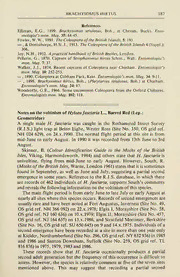
Notes on the voltinism of Hylaea fasciaria L., barred red (Lep.: Geometridae) PDF
Preview Notes on the voltinism of Hylaea fasciaria L., barred red (Lep.: Geometridae)
BRACHYSOMUS HIRTUS 187 References Elliman, E.G., 1899. Brachysomus setulosus. Boh., at Chesam, Bucks. Ento- mologist'smon. Mag. 35: 44-45. —Fowler, W.W., 1891. TTje Coleopteraofthe British Islands, 5: 193. & Donisthorpe, H.St.J., 1913. The Coleoptera ofthe British Islands6 (Suppl.): , 306. Joy, N.H., 1932. A practicalhandbookofBritish Beetles, London. Pellerin, G., 1870. Capture of Strophosomus hirtus Schon., Walt. Entomologist's mon. Mag. 7: 37. Walker, J.J., 1874. Recent captures of Coleoptera near Chatham. Entomologist's mon. Mag. 10:252-253. — 1890. Coleopteraat Cobham Park, Kent. Entomologist'smon. Mag. 34: 9-11. — , 1898. Brachysomus hirtus, Boh., (Platytarsus setulosus, Boh.) at Chatham. , Entomologist'smon. Mag. 34: 17. Woodroffe, G.E., 1966. Some uncommon Coleoptera from the Oxford Chilterns. Entomologistsmon. Mag. 102: 118. Notes on the voltinism ofHylaeafasciaria L., Barred Red (Lep.: Geometridae) A single male H. fasciaria was caught in the Rothamsted Insect Survey (R.I.S.) light trap at Beinn Eighe, Wester Ross (Site No. 350, OS grid ref. NH 024 629), on 24.x.1990. The normal flight period at this site is from mid-June to early August. In 1990 it was recorded from 13th June to 3rd August. Skinner, B. {Colour Identification Guide to the Moths of the British Isles, Viking, Harmondsworth, 1984) and others state that H. fasciaria is univoltine, flying from mid-June to early August. However, South, R. {Moths oftheBritish Isles, Warne, London 1961) states that it is sometimes found in September, as well as June and July, suggesting a partial second emergence in some years. Reference to the R.I.S. database, in which there are records of 462 individuals of H. fasciaria, supports South's comments and reveals the following information on the voltinism ofthis species. The main flight period is from early June to late July or early August at nearly all sites where this species occurs. Records of second emergences are usually rare and have been noted at Fort Augustus, Inverness (Site No. 49, OS grid ref. NH 366 092) on 22.x.1978; Elgin I, Morayshire (Site No. 58, OS grid ref. NJ 160 636) on 10.x.1979; Elgin II, Morayshire (Site No. 457, OS grid ref. NJ 164 635) on 13.x.1986, and Stratfield Mortimer, Berkshire (Site No. 16, OS grid ref. SU 650 645) on 9 and 14.x.1975. Individuals of a second emergence have been recorded at a site in more than one year only at Kielder, Northumberland (Site No. 296, OS grid ref. NY 632 936) in 1985 and 1986 and Santon Downham, Suffolk (Site No. 259, OS grid ref. TL 816 876) in 1975, 1979, 1983 and 1986. These records show that H. fasciaria occasionally produces a partial second adult generation but the frequency of this occurrence is difficult to assess. However, the species is relatively common at five of the seven sites mentioned above. This may suggest that recording a partial second — 188 ENTOMOLOGIST'S RECORD, VOL. 103 15.vii.l991 emergence is dependent on the abundance of the species at the trapping site. Further observation is required to clarifythis. Records from the R.LS. trap on Guernsey (Site No. 252, grid ref. 49° 26.2'N, 2° 34.3'W) and Jersey (Site No. 146, grid ref. 49° 14'N, 2° 5.5'W) indicate that the flight period on the Channel Islands is somewhat different to that in mainland Britain. At the Guernsey trap, in which the species is more commonly caught than at Jersey, it is consistently recorded between early July and early October, though occasionally the flight period is from early June to early September. Individuals occur randomly throughout the flight period but, at these sites, are always few. Further recording on the islands, where the samples are larger, may reveal interesting observations on the phenology ofthis species. Climatic change may affect the phenology of H. fasciaria in the future but the frequency of bivoltinism and the factors influencing it should be assessed more thoroughlyin the meantime. Thanks are extended to the operators of the traps mentioned in this article for their continued co-operation. Adrian M. Riley, Dept. Entomology & Nematology, AFRC Farmland Ecology Research Group, Rothamsted Exp. Stn., Harpenden, Herts AL5 2JQ. The Magpie Moth in North-west Scotland B.K. West's article on the status of Abraxas grossulariata L. {Ent. Rec. 103: 89) was of considerable interest to me. This is a common and widespread moth, associated with heather and bog myrtle in the coastal regions and inshore islands ofN.W. Sutherland and Wester Ross, from the Applecross peninsula clockwise to the Kyle of Tongue (an area I have covered annually since 1964 while leading small parties of our Highland NG NG Safaris). The 10km squares where noticed are 74 (Applecross), 85 NG NH NG NB and 95 (Torridon), 96 and 06 (Loch Maree), 78 (Melvaig), 90 (Tanera More, Summer Isles), NC 13 and 23 (Drumbeg and Kylesku district), NC 14 (Handa RSPB island reserve and Tarbet), NC 15, 25, 26, 27, 37, 36 and 35 (Sandwood Bay, Cape Wrath peninsula, Durness to Loch Eriboll) and NC 56 (Melness). In 26 years I have found—none more than a few miles inland and only a single specimen in the east this near Strathpeffer (NH 45) on 1st August 1975. This species is sometimes very common as on 16th July 1985 along the scenic Ardmore path, near Rhiconich, and on 5th July 1986 at Melvaig, north of Gairloch, but the most remarkable mass emergence was on the cloudy bright afternoon of 3rd July 1984, when many hundreds were flying or at rest on heather along the peat-cutters' track leading inland from Loch Drumbeg. The flight period in the Highland Region is from 29th June (1978) to 15th August (1986).— Derek C. Hulme, Ord Drive, Muir of Ord, Ross-shire IV6 7UQ.
